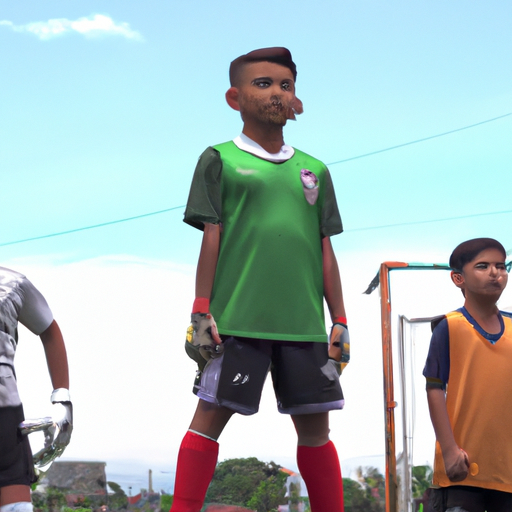From Grassroots to Glory: The Journey of Philippine Soccer Teams

The Rise of Philippine Soccer: From Grassroots to Glory
The Rise of Philippine Soccer: From Grassroots to Glory
Soccer, or football as it is known in many parts of the world, has long been a beloved sport in the Philippines. However, it is only in recent years that the country’s soccer teams have started to make a name for themselves on the international stage. This article will explore the journey of Philippine soccer teams, from their humble grassroots beginnings to their rise to glory.
The story of Philippine soccer begins with the establishment of the Philippine Football Federation (PFF) in 1907. At that time, soccer was still a relatively unknown sport in the country, with basketball and boxing dominating the sports scene. However, a small group of passionate individuals saw the potential of soccer and worked tirelessly to promote and develop the sport.
In the early years, Philippine soccer teams faced numerous challenges. The lack of proper facilities, training programs, and financial support hindered their progress. Despite these obstacles, the teams persevered, relying on their sheer determination and love for the game. They played on makeshift fields, often using whatever materials they could find to mark the boundaries. It was truly a grassroots movement, with players and coaches sacrificing their time and resources to keep the sport alive.
As the years went by, Philippine soccer slowly gained traction. The PFF organized local tournaments and leagues, providing a platform for aspiring players to showcase their skills. The establishment of youth development programs also played a crucial role in nurturing young talents and honing their abilities. These initiatives helped lay the foundation for the future success of Philippine soccer.
The turning point for Philippine soccer came in the early 2010s when the national team, known as the Azkals, made history by qualifying for the AFC Asian Cup for the first time. This achievement put Philippine soccer on the map and generated a newfound interest in the sport. Suddenly, soccer became a source of national pride, and more young Filipinos began dreaming of representing their country on the international stage.
With the increased attention and support, Philippine soccer teams started to attract talented players from around the world. Many players of Filipino descent, who had previously represented other countries, chose to play for the Philippines, adding depth and skill to the national team. This influx of talent, combined with the continued development of local players, propelled Philippine soccer to new heights.
Today, Philippine soccer teams continue to make strides in their quest for glory. The Azkals have become a force to be reckoned with in Southeast Asia, consistently performing well in regional tournaments. The women’s national team, the Malditas, has also made significant progress, competing in international competitions and raising the profile of women’s soccer in the country.
The journey of Philippine soccer teams from grassroots to glory is a testament to the power of passion, perseverance, and dedication. It is a story of individuals who believed in the potential of the sport and worked tirelessly to make their dreams a reality. As Philippine soccer continues to grow and evolve, it is clear that the future holds even greater success and recognition for the teams and players who have dedicated themselves to the beautiful game.
Inspiring Stories of Philippine Soccer Teams: A Journey to Success

From Grassroots to Glory: The Journey of Philippine Soccer Teams
Soccer, or football as it is known in many parts of the world, has always been a popular sport in the Philippines. However, it is only in recent years that the country’s soccer teams have started to make a name for themselves on the international stage. This article will explore the inspiring stories of Philippine soccer teams and their journey to success.
The journey of Philippine soccer teams begins at the grassroots level. In a country where basketball is the dominant sport, soccer often takes a backseat. However, passionate individuals and organizations have been working tirelessly to change this. They have been organizing grassroots programs and tournaments to develop young talent and promote the sport.
One such organization is the Philippine Football Federation (PFF). The PFF has been instrumental in the development of soccer in the country. They have been working closely with schools and communities to introduce the sport to young children. Through their efforts, more and more kids are now getting involved in soccer at a young age.
As these young players progress, they join local clubs and academies that provide them with further training and opportunities to showcase their skills. These clubs and academies play a crucial role in nurturing talent and preparing players for the next level. They provide professional coaching, state-of-the-art facilities, and exposure to competitive leagues.
One notable success story is the Ceres-Negros Football Club. Founded in 2012, the club quickly rose through the ranks of Philippine soccer. They dominated the domestic league and made their mark in international competitions. In 2017, they became the first Philippine club to reach the AFC Cup ASEAN Zonal Final. Their success has inspired many young players and fans across the country.
Another inspiring story is the Philippine Women’s National Team. Despite facing numerous challenges, including limited resources and support, the team has managed to achieve remarkable success. They have consistently performed well in regional tournaments and have even qualified for the AFC Women’s Asian Cup. Their determination and resilience have made them role models for aspiring female soccer players in the Philippines.
The journey to success for Philippine soccer teams is not without its obstacles. Limited funding, lack of infrastructure, and the dominance of other sports pose significant challenges. However, the passion and dedication of players, coaches, and supporters continue to drive the growth of the sport.
The success of Philippine soccer teams has not gone unnoticed. International organizations and sponsors have started to take notice and provide support. This has led to increased opportunities for players to compete in international tournaments and gain exposure to higher levels of competition.
In conclusion, the journey of Philippine soccer teams from grassroots to glory is a testament to the passion and determination of individuals and organizations involved in the sport. Through their efforts, soccer in the Philippines is slowly but surely gaining recognition and success on the international stage. The inspiring stories of these teams serve as a reminder that with hard work and dedication, dreams can become a reality.
Building a Strong Foundation: The Development of Philippine Soccer
From Grassroots to Glory: The Journey of Philippine Soccer Teams
Building a Strong Foundation: The Development of Philippine Soccer
Soccer, or football as it is known in many parts of the world, has always been a popular sport in the Philippines. However, it is only in recent years that the country has started to make significant strides in the development of its soccer teams. This article will explore the journey of Philippine soccer, from its grassroots beginnings to its current position as a rising force in the international soccer scene.
The development of Philippine soccer can be traced back to the early 20th century when the sport was introduced by American teachers and soldiers. It quickly gained popularity among the locals, and various clubs and leagues were formed. However, due to a lack of resources and infrastructure, the growth of the sport was slow and limited to certain regions.
In the 1990s, the Philippine Football Federation (PFF) was established to oversee the development of soccer in the country. This marked a turning point for Philippine soccer, as the PFF began implementing programs and initiatives to promote the sport at all levels. Grassroots development became a key focus, with the establishment of youth academies and training centers across the country.
One of the major challenges faced by Philippine soccer was the lack of proper facilities and training grounds. Recognizing this, the PFF partnered with local government units and private organizations to build soccer fields and training centers. This investment in infrastructure provided aspiring young players with the necessary facilities to hone their skills and develop their talent.
Another crucial aspect of the development of Philippine soccer was the emphasis on coaching education. The PFF introduced coaching courses and workshops to improve the quality of coaching at all levels. This not only benefited the players but also helped raise the overall standard of the sport in the country.
As the grassroots development programs started to bear fruit, Philippine soccer began to gain recognition on the international stage. The national team, known as the Azkals, made history in 2010 by qualifying for the AFC Challenge Cup for the first time. This achievement brought attention to Philippine soccer and sparked a renewed interest in the sport among the Filipino population.
The success of the national team also led to increased investment in the sport. Corporate sponsors and private investors started to see the potential of Philippine soccer and began providing financial support to clubs and players. This influx of resources allowed for the professionalization of the sport, with the establishment of professional leagues and the signing of foreign players to strengthen local teams.
Today, Philippine soccer continues to grow and evolve. The national team has achieved further success, qualifying for the AFC Asian Cup in 2019. The domestic leagues have become more competitive, attracting talented players from both local and international backgrounds. The grassroots development programs are still in place, nurturing young talents and ensuring a steady supply of skilled players for the future.
In conclusion, the journey of Philippine soccer from its grassroots beginnings to its current position as a rising force in the international soccer scene is a testament to the dedication and hard work of the players, coaches, and administrators involved. Through the development of grassroots programs, investment in infrastructure, and the professionalization of the sport, Philippine soccer has built a strong foundation for future success. With continued support and investment, the future looks bright for Philippine soccer, and the country may soon achieve even greater glory on the global stage.





